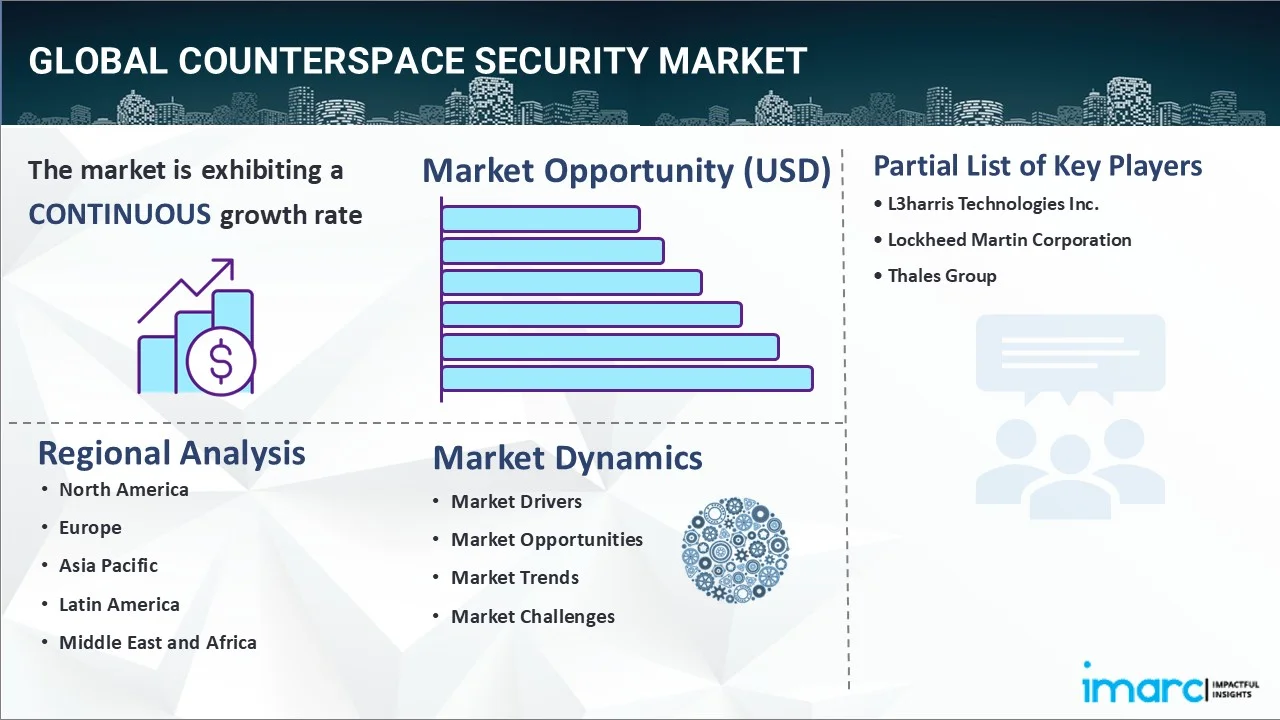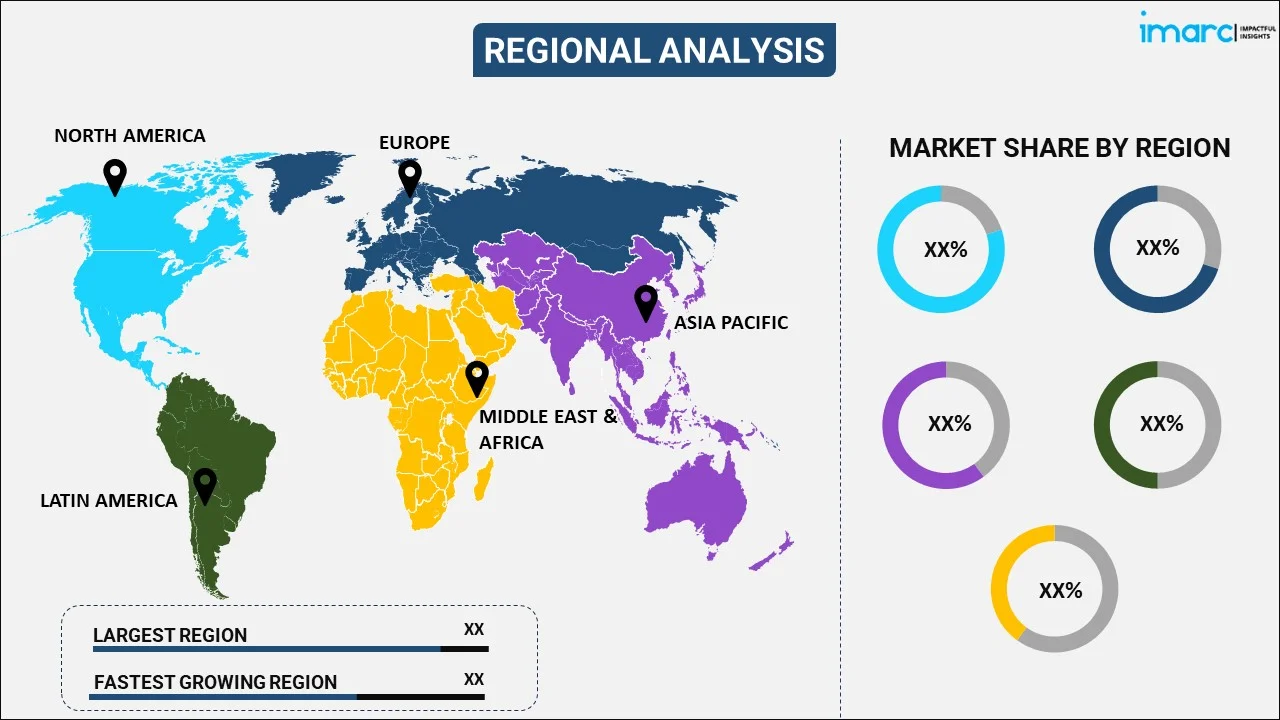
Counterspace Security Market Report by Product Type (Co-Orbital Systems, Non-Kinetic Physical Systems, Space-Based Electronic Warfare Systems, Space Situational Awareness, Cybersecurity), Deployment Model (LEO, MEO, GEO, Ground-Based), Application (Commercial, Military), and Region 2025-2033
Market Overview:
The global counterspace security market size reached USD 8.1 Billion in 2024. Looking forward, IMARC Group expects the market to reach USD 16.7 Billion by 2033, exhibiting a growth rate (CAGR) of 8.3% during 2025-2033. The rising demand for satellite-based services, development of new technologies, such as quantum encryption, and favorable government initiatives to increase security and safety on space exploration activities represent some of the key factors driving the market.
|
Report Attribute
|
Key Statistics
|
|---|---|
|
Base Year
|
2024
|
|
Forecast Years
|
2025-2033
|
|
Historical Years
|
2019-2024
|
|
Market Size in 2024
|
USD 8.1 Billion |
|
Market Forecast in 2033
|
USD 16.7 Billion |
| Market Growth Rate 2025-2033 | 8.3% |
Counterspace security involves various techniques to identify and mitigate potential threats and provides a secure platform for businesses to store and manage sensitive information. It uses advanced analytics and machine learning algorithms to detect threats in real time and block them before they can cause any damage. These techniques include network monitoring, vulnerability scanning, malware detection, access control management, threat detection and response mechanisms. Counterspace security uses a combination of network security, access control, identity management, and data encryption to protect organizations from potential threats. It provides real-time protection against malware, ransomware, phishing attacks, and zero-day exploits. The security system also provides a comprehensive view of the organization's security posture by providing advanced encryption technologies, allowing for better decision-making regarding security policies. Furthermore, it can be used to detect suspicious activity on the network and alert administrators, if necessary, thereby helping organizations reduce their risks of data breaches.

Counterspace Security Market Trends:
The global market is primarily driven by the growing demand for secure communication networks, data transmission, and data protection solutions. This can be attributed to a considerable rise in the number of threats from malicious cyber-attacks and space debris in the space domain. Moreover, continual technological advancements in satellite imaging and navigation systems, along with the development of new technologies, such as quantum encryption, are fueling the market growth. In line with this, the increasing investments in counterspace security technologies and advanced space-based cyber defense solutions by the government bodies of several countries are providing an impetus to the market. Favorable government initiatives to increase security and safety of space exploration activities are also resulting in a higher uptake of counterspace security. The market is further driven by the increasing adoption of cloud-based services across numerous end-use industries on the global level. Apart from this, extensive research and development (R&D), new business models, and partnerships and collaboration strategies adopted by the key players are also impacting the market positively. Some of the other factors contributing to the market include the rising demand for satellite-based services, the development of 5G infrastructure across the globe and the widespread adoption of remote working models by small and medium enterprises.
Key Market Segmentation:
IMARC Group provides an analysis of the key trends in each segment of the global counterspace security market, along with forecasts at the global, regional, and country level from 2025-2033. Our report has categorized the market based on product type, deployment model, and application.
Product Type Insights:

- Co-Orbital Systems
- Non-Kinetic Physical Systems
- High-Powered Laser
- High-Powered Microwave
- Space-Based Electronic Warfare Systems
- Jammers
- Antennas
- Radar Warning Receivers (RWR)
- Space Situational Awareness
- Radars
- Optics
- Laser Ranging
- Signal Intelligence (SIGINT)
- Cybersecurity
The report has provided a detailed breakup and analysis of the counterspace security market based on the product type. This includes co-orbital systems, non-kinetic physical systems (high-powered laser and high-powered microwave), space-based electronic warfare systems (jammers, antennas, and radar warning receivers), space situational awareness (radars, optics, laser ranging, and signal intelligence), and cybersecurity. According to the report, co-orbital systems represented the largest segment.
Deployment Model Insights
- LEO
- MEO
- GEO
- Ground-Based
The report has provided a detailed breakup and analysis of the counterspace security market based on the deployment model. This includes LEO, MEO, GEO, and ground-based. According to the report, ground-based represented the largest segment.
Application Insights
- Commercial
- Military
A detailed breakup and analysis of the counterspace security market based on the application has also been provided in the report. This includes military and commercial. According to the report, military accounted for the largest market share.
Regional Insights:

- North America
- United States
- Canada
- Asia Pacific
- China
- Japan
- India
- South Korea
- Australia
- Indonesia
- Others
- Europe
- Germany
- France
- United Kingdom
- Italy
- Spain
- Russia
- Others
- Latin America
- Brazil
- Mexico
- Others
- Middle East and Africa
The report has also provided a comprehensive analysis of all the major regional markets that include North America (the United States and Canada); Asia Pacific (China, Japan, India, South Korea, Australia, Indonesia, and others); Europe (Germany, France, the United Kingdom, Italy, Spain, Russia, and others); Latin America (Brazil, Mexico, and others); and Middle East and Africa. According to the report, North America was the largest market for counterspace security. Some of the factors driving the North America counterspace security market include continual technological advancements in counterspace security solutions, the growing demand for secure communication networks, rapid digitization, etc.
Competitive Landscape
The report has also provided a comprehensive analysis of the competitive landscape in the global counterspace security market. Detailed profiles of all major companies have also been provided. Some of the companies covered include L3harris Technologies Inc., Lockheed Martin Corporation, Thales Group, etc. Kindly note that this only represents a partial list of companies, and the complete list has been provided in the report.
Report Coverage:
| Report Features | Details |
|---|---|
| Base Year of the Analysis | 2024 |
| Historical Period | 2019-2024 |
| Forecast Period | 2025-2033 |
| Units | Billion USD |
| Product Types Covered |
|
| Deployment Models Covered | LEO, MEO, GEO, Ground-Based |
| Applications Covered | Commercial, Military |
| Regions Covered | Asia Pacific, Europe, North America, Latin America, Middle East and Africa |
| Countries Covered | United States, Canada, Germany, France, United Kingdom, Italy, Spain, Russia, China, Japan, India, South Korea, Australia, Indonesia, Brazil, Mexico |
| Companies Covered | L3harris Technologies Inc., Lockheed Martin Corporation, Thales Group, etc. |
| Customization Scope | 10% Free Customization |
| Post-Sale Analyst Support | 10-12 Weeks |
| Delivery Format | PDF and Excel through Email (We can also provide the editable version of the report in PPT/Word format on special request) |
Key Benefits for Stakeholders:
- IMARC’s report offers a comprehensive quantitative analysis of various market segments, historical and current market trends, market forecasts, and dynamics of the counterspace security market from 2019-2033.
- The research study provides the latest information on the market drivers, challenges, and opportunities in the global counterspace security market.
- The study maps the leading as well as the fastest growing regional markets. It further enables stakeholders to identify the key country-level markets within each region.
- Porter's five forces analysis assist stakeholders in assessing the impact of new entrants, competitive rivalry, supplier power, buyer power, and the threat of substitution. It helps stakeholders to analyze the level of competition within the counterspace security industry and its attractiveness.
- Competitive landscape allows stakeholders to understand their competitive environment and provides an insight into the current positions of key players in the market.
Key Questions Answered in This Report
The counterspace security market was valued at USD 8.1 Billion in 2024.
The counterspace security market is projected to exhibit a CAGR of 8.3% during 2025-2033, reaching a value of USD 16.7 Billion by 2033.
The market is primarily driven by the rising demand for secure satellite communication networks, advancements in space situational awareness technologies, and the development of sophisticated cyber defense solutions. Increasing threats from cyber-attacks and space debris, alongside favorable government initiatives to enhance space security, further propel market growth across global industries.
North America currently dominates the counterspace security market, accounting for the largest share in 2024. This dominance is supported by technological advancements in counterspace solutions, significant defense investments, and heightened demand for space-based cybersecurity infrastructure in the region.
Some of the major players in the counterspace security market include L3Harris Technologies Inc., Lockheed Martin Corporation, and Thales Group, among others.
Need more help?
- Speak to our experienced analysts for insights on the current market scenarios.
- Include additional segments and countries to customize the report as per your requirement.
- Gain an unparalleled competitive advantage in your domain by understanding how to utilize the report and positively impacting your operations and revenue.
- For further assistance, please connect with our analysts.
 Request Customization
Request Customization
 Speak to an Analyst
Speak to an Analyst
 Request Brochure
Request Brochure
 Inquire Before Buying
Inquire Before Buying




.webp)




.webp)












